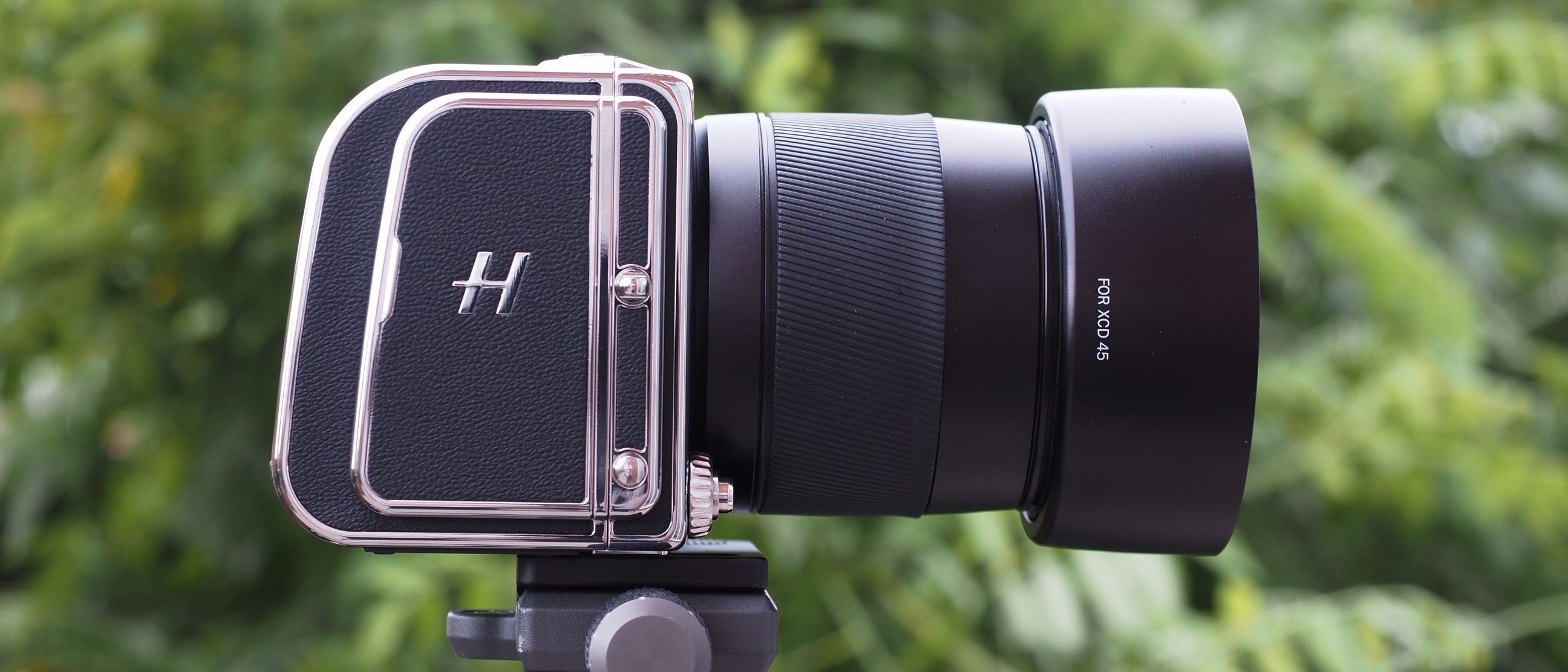Digital Camera World Verdict
Our five-star rating needs to be viewed in context. By regular camera standards, the 907X 50C is pretty slow and awkward. But it’s not designed to compete with regular cameras. This is a professional tool designed for careful, considered, commercial use that is part of a hugely flexible modular system – but at a fraction of the cost these systems usually entail.
Pros
- +
Low cost for a modular system
- +
Simple assembly and operation
- +
CFV II 50C fits the old 500CM
- +
Same lenses as X1D II 50C
Cons
- -
Screen hard to see in bright light
- -
AF is slow and noisy
Why you can trust Digital Camera World
The Hasselblad 907X 50C achieves two remarkable things. It’s an affordable entry point to Hasselblad’s modular medium format system, and it also resurrects the classic Hasselblad 500 film camera range, and at a price that makes bringing these cameras out of retirement a feasible proposition, especially as many are still working today.
Hasselblad’s modular medium format cameras now come in two types. You have the big, bulky and expensive H6, the latest in the Hasselblad ‘H’ series of digital SLRs. This is sold with a 100MP digital back with a sensor roughly the size of old medium format 645 (6x4.5cm) film, once you allow for a few millimetre rebate around the film area. This is so-called ‘full frame’ digital medium format. The H6D-100c costs around $33,000, body only.
And now we have the 907x, a smaller camera with a smaller 50MP sensor. It’s still medium format, and 67% larger in area than full frame, and you can think of it as having the same relationship to ‘true’ full frame medium format as APS-C sensors have to full frame.
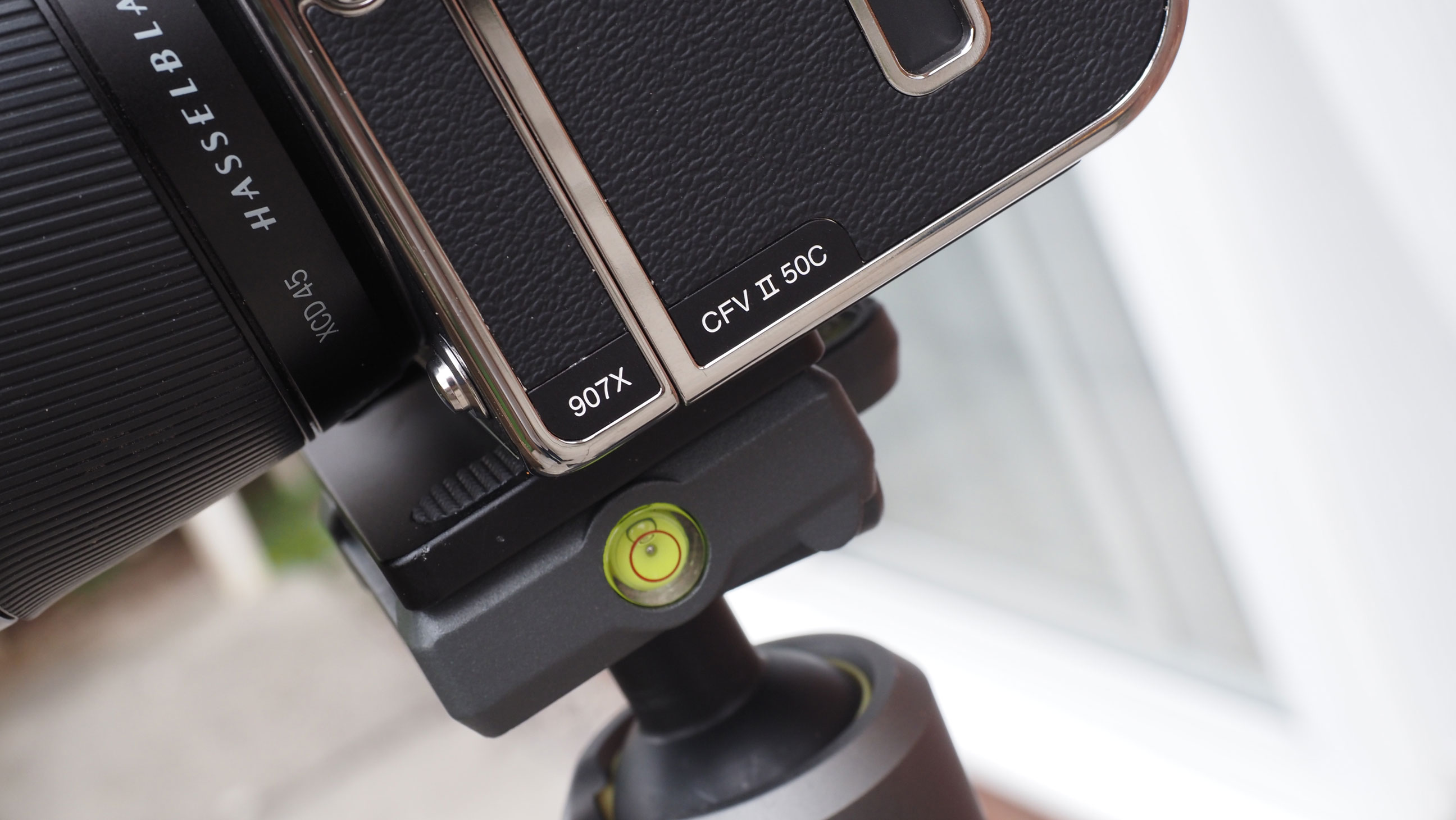
This is still a big sensor. More to the point, the fact that it’s not ‘full frame’ medium format makes it massively more affordable. The 907X sells for around $6,400, body only. That’s a little more than the best full frame cameras, but one-fifth the price of the H6D – one fifth!
We presume the 907X 50c uses the same sensor as the Hasselblad X1D II 50C, and it certainly uses the same XCD lenses – it can also use all HC/HCD, V System and XPan Lenses via adapters.
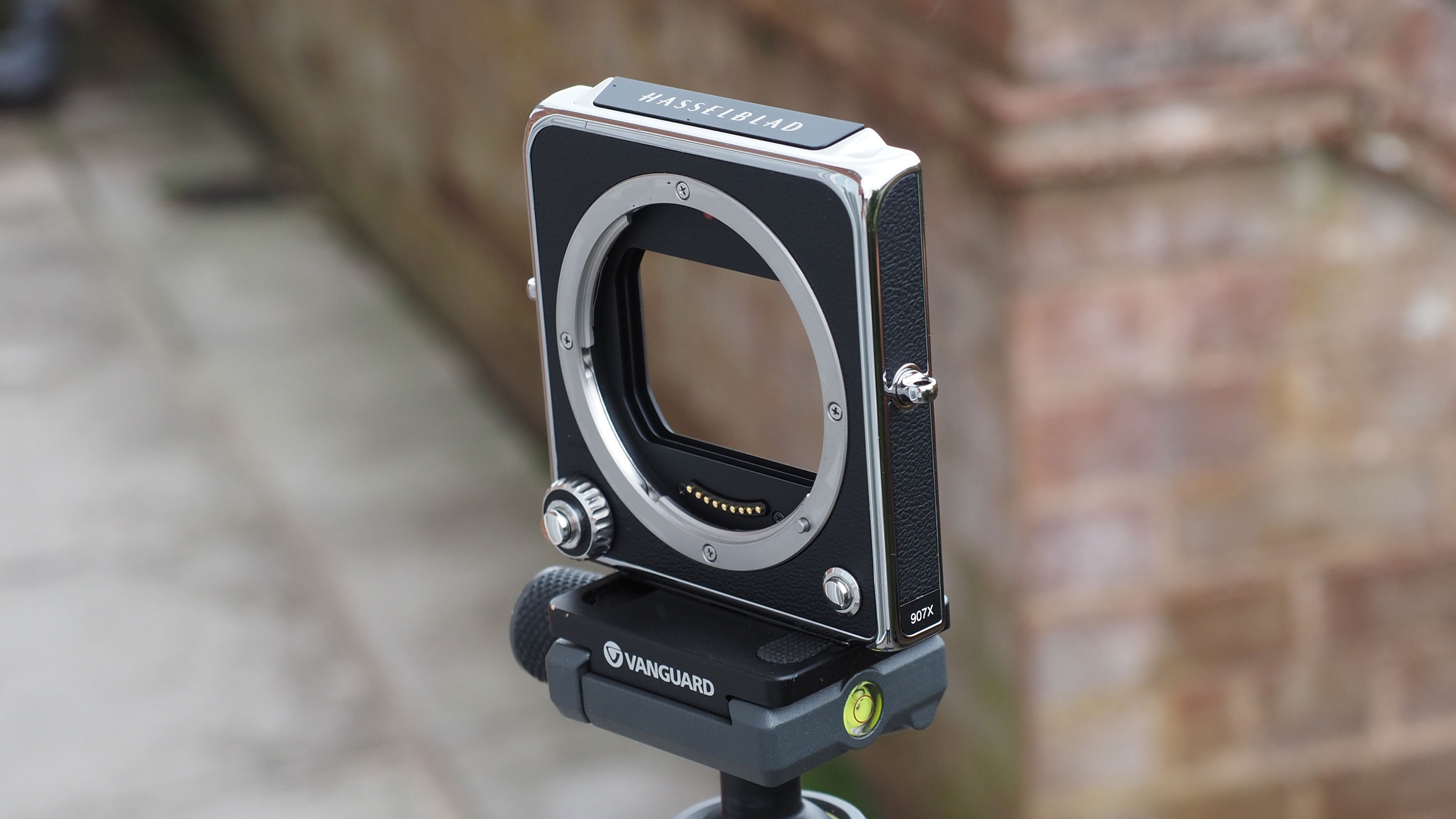
But while the sensor and lenses might be the same, this is an utterly different camera design. The X1D 50C II is a regular mirrorless camera with the sensor integrated into the body along with an electronic viewfinder, whereas the 907X 50C is a modular camera in to parts. It consists of the 907X camera body and CFV II 50C digital back. These are sold together but can be used separately.
We don’t know what Hasselblad’s future plans are for the 907X body, but you can attach the CVF II 50C back directly to a Hasselblad 500 c/m film camera, without adapters, without modifications, without calibration, without any extra accessories. If ever we wondered what the point was of a modular camera system, we just found out.
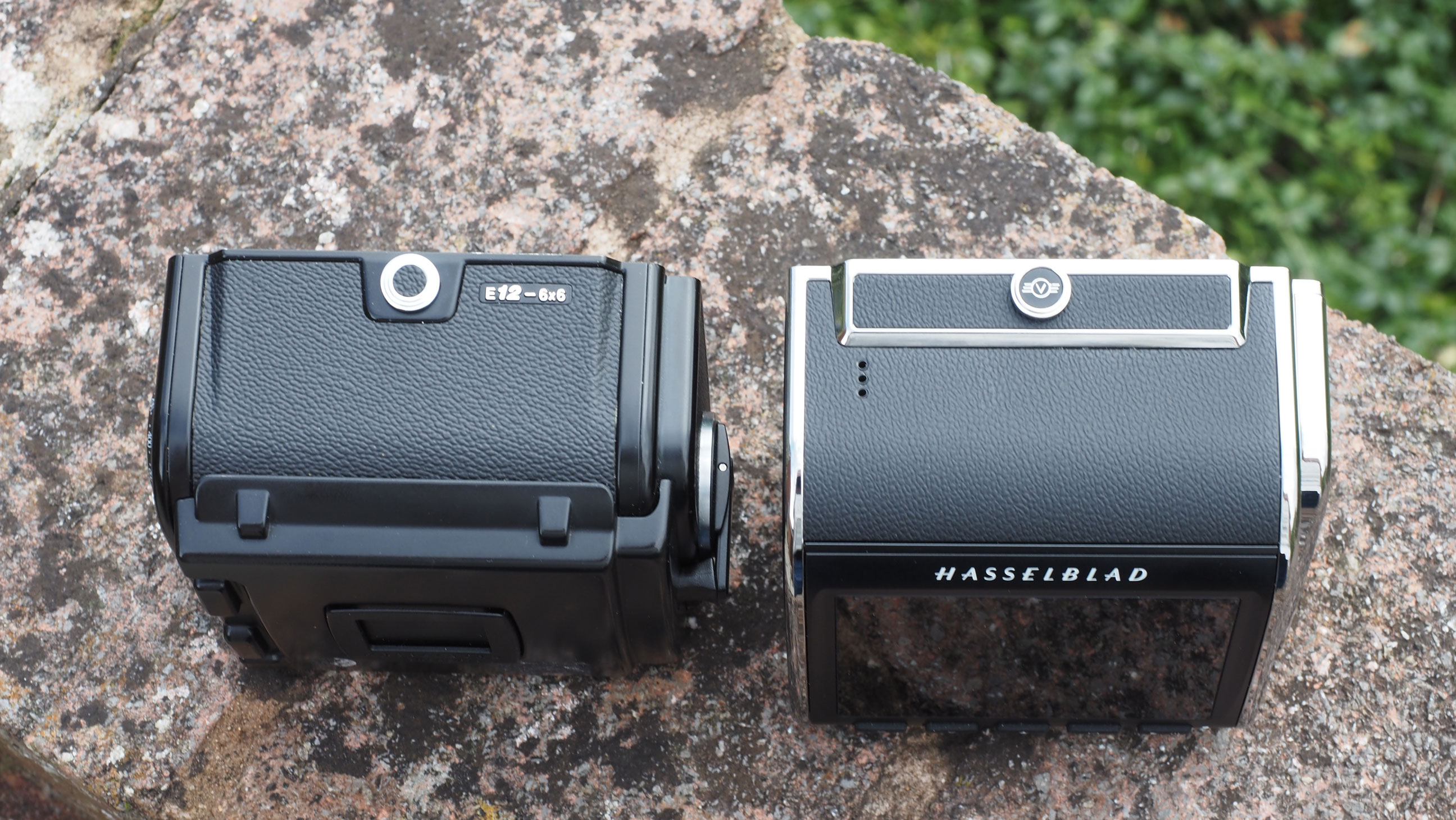
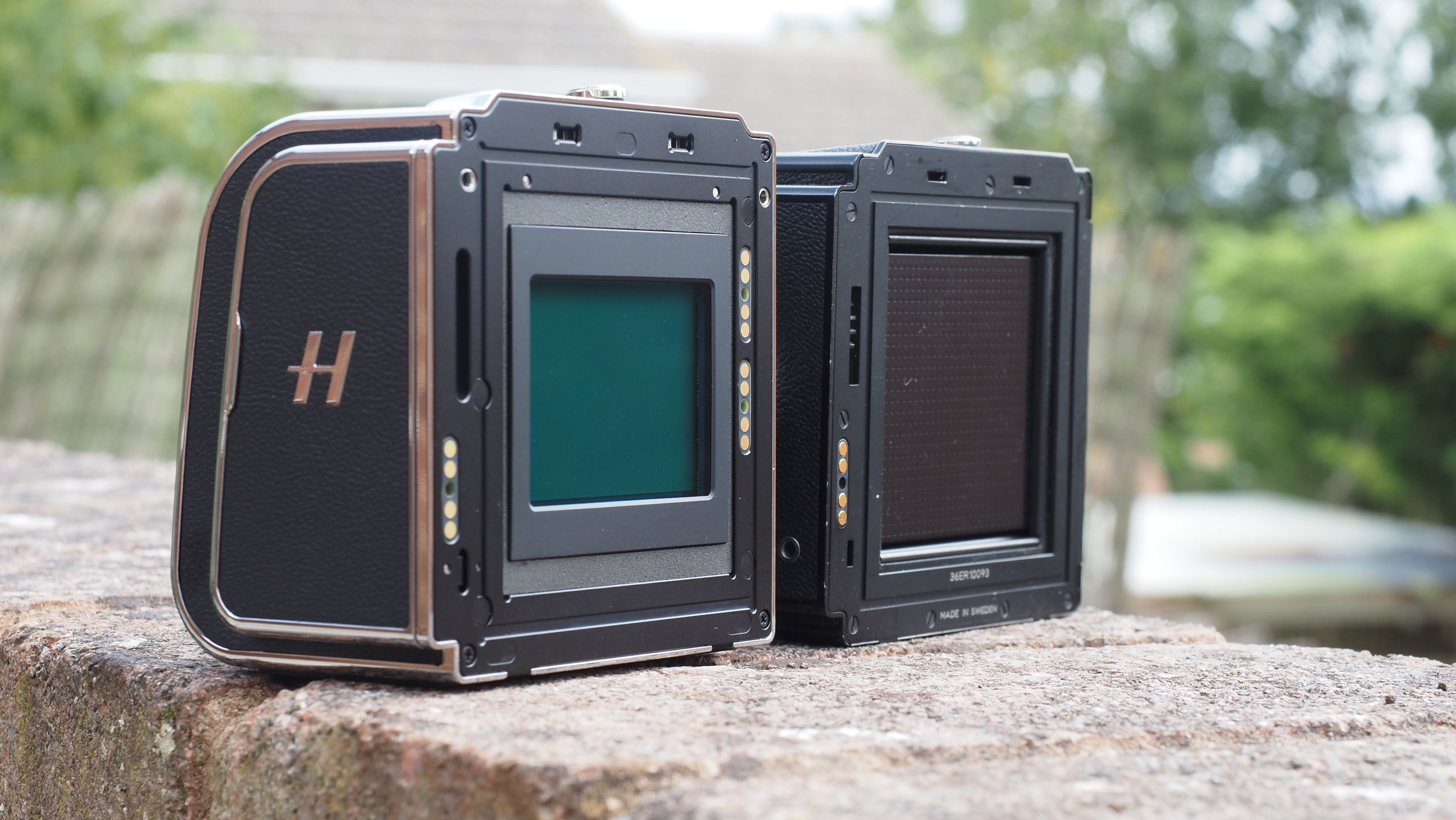
If you want a medium format mirrorless camera, get the Hasselblad X1D II 50C (or a Fujifilm GFX 50S). If you want a modular medium format camera that can interface with other Hasselblad equipment, old and new, get the 907X 50C.
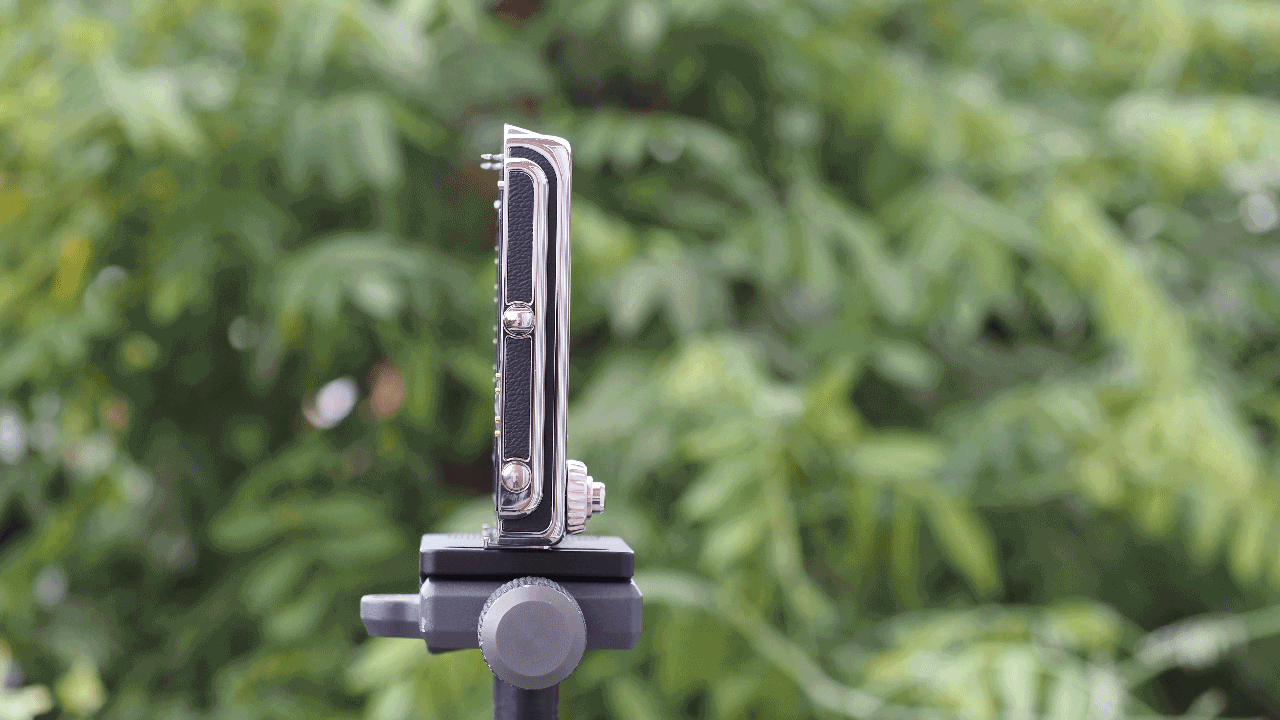
Specifications
Sensor: 50MP medium format CMOS sensor, 43.8x32.9mm
Image processor: Not quoted
AF points: 117-point contrast AF
ISO range: 100-25,600
Metering modes: Spot, center weighted, center spot
Video: 2.7K (2720 x 1530) up to 30p
Viewfinder: None (optional extra)
Memory card: 2x SD/SDHC/SDXC, UHS-II
LCD: 32-inch tilting touchscreen, 2.36m dots
Max burst: Not quoted
Connectivity: Wi-Fi
Size: 102 × 93 × 84mm
Weight: 740g (907X + CFV II 50C), excluding battery and memory card
Key features
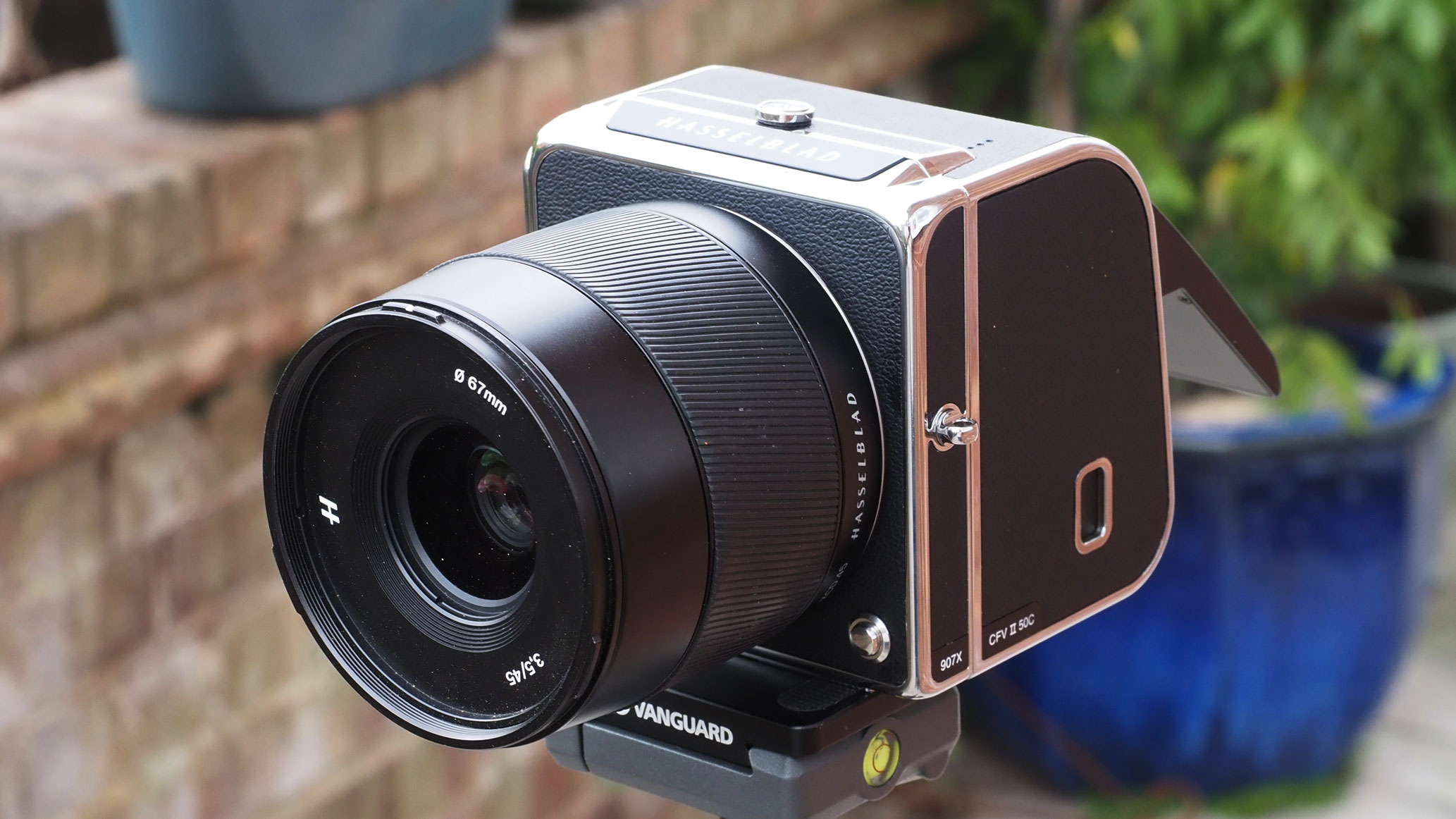
The 907X, as we’ve said, comes in two parts. The 907X is, you might say, the ‘body’, but really you could look at it as a kind of glorified lens adaptor, a physical interface between the lenses and the detachable CFV II 50C back. It weighs just 200g. It does, however, house a tripod socket.
It will be interesting to see how Hasselblad develops this product line, and whether there will be new backs in the future. At the moment, the interchangeability mostly benefits Hasselblad’s 500 (V-series) film cameras. (There is even a focusing screen mask included to show the different sensor size of the CFV II 50C when shooting with a Hasselblad 500.)
This CVF II 50C back might look familiar, as a close relative of the 50MP back for the Hasselblad H6 series. It is, however, a ‘refreshed’ version that now has a tilting mechanism and touch control and improved live view with a 60fps refresh rate and a focus peaking option. It also has an integrated battery slot. Hasselblad says the CFV II 50C has ‘outstanding’ color depth and 14 stops of dynamic range.
Build and handling
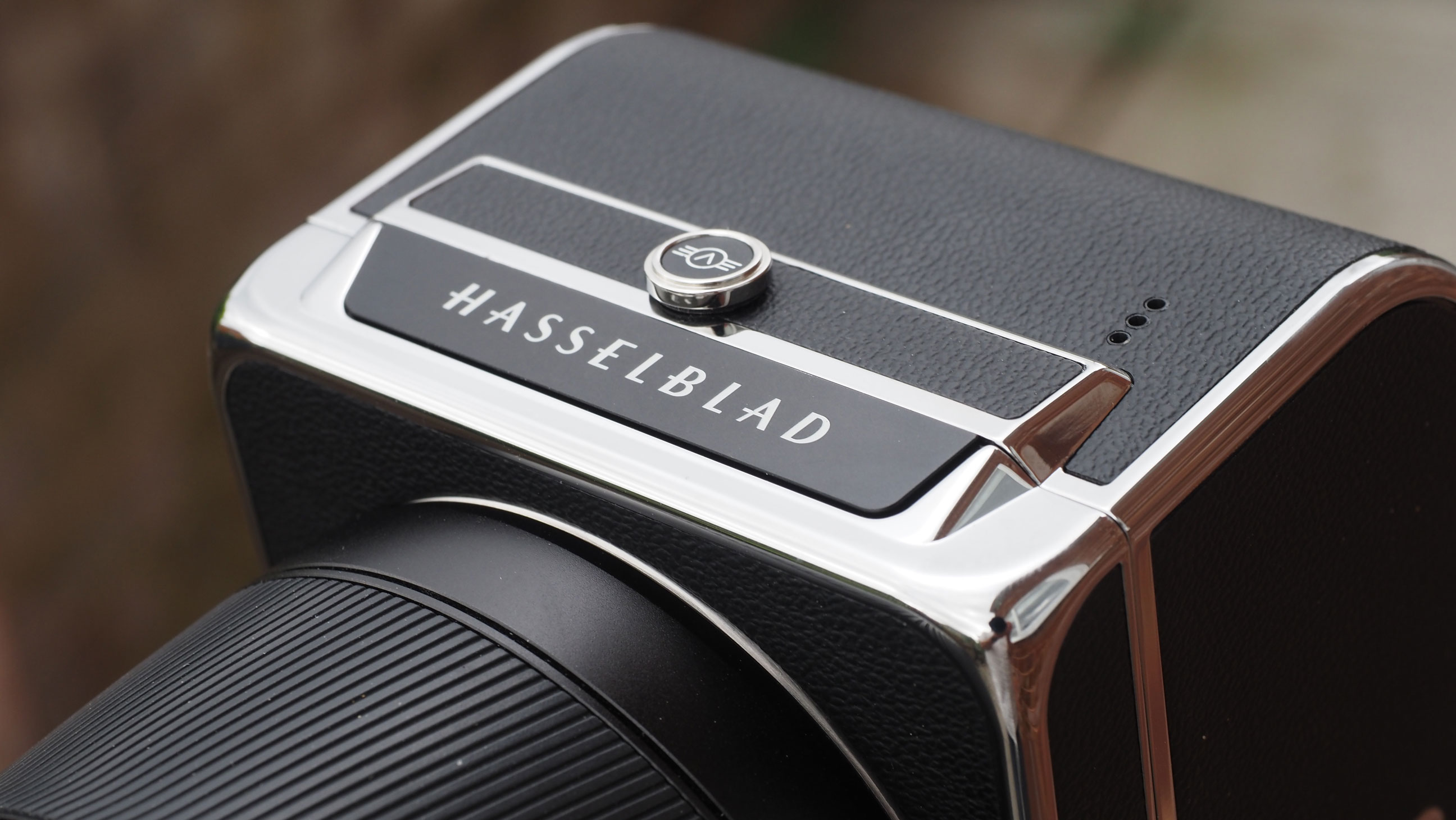
Let’s get the obvious things out of the way first. The 907X 50C can be used handheld, but it’s not in its element. It’s easy enough to hold, but without a conventional grip you wouldn’t want to carry it around one-handed without the extra security of a strap.
The shutter release is on the front, below and to the right of the lens. It sounds odd, but it’s a great position given the camera’s shape, and in exactly the same place as Hasselblad’s classic 500-series ‘V’ cameras.
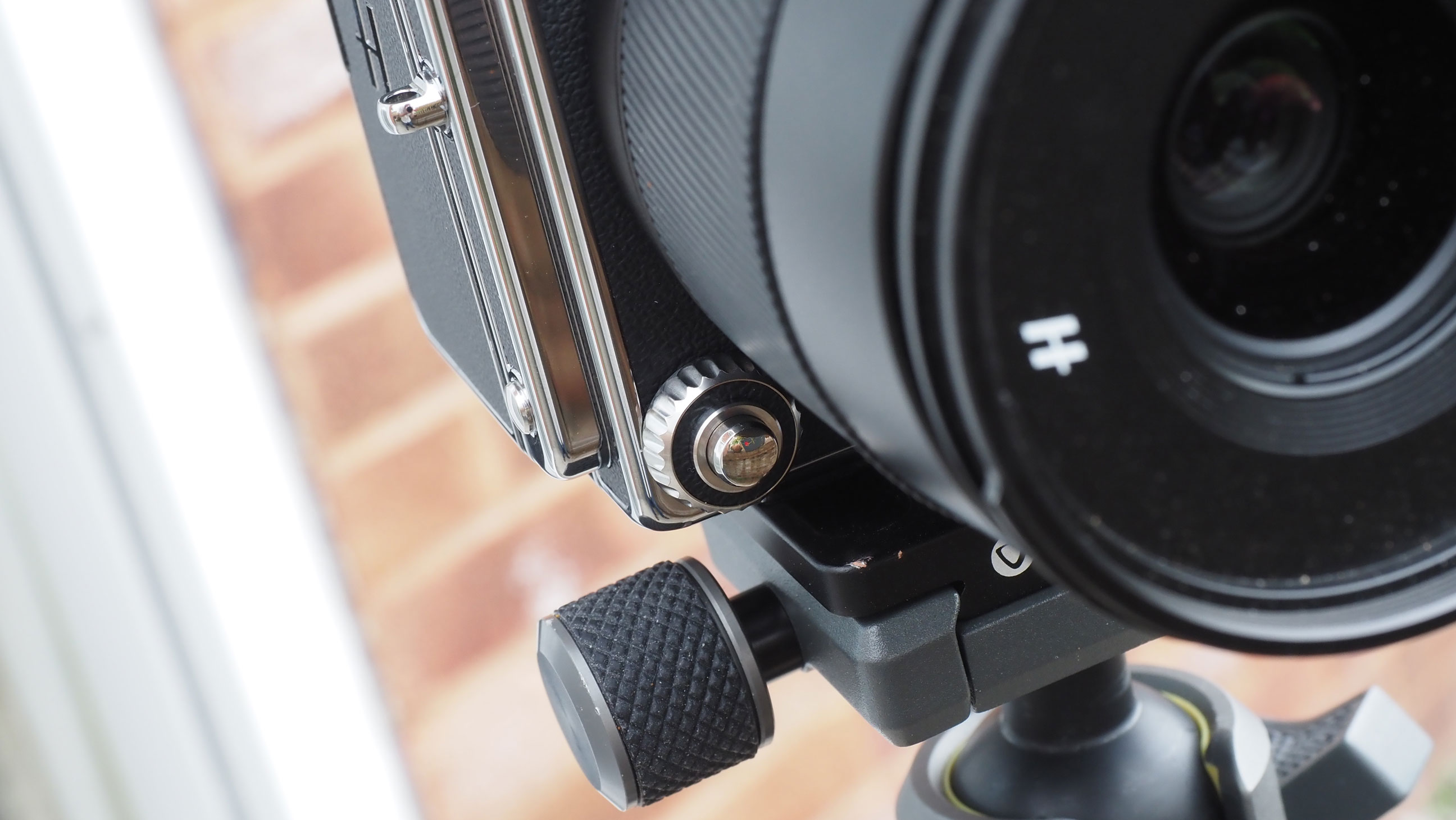
The shape is OK for handheld photography, but a couple of other things work against it. The tilting rear screen is super sharp and clear indoors, but easily swamped by bright light and glare outdoors. You might want to think about the optional 907X optical viewfinder, sold separately.
If the camera is on a tripod and you’ve got the time to work carefully it’s not an issue. You can shade the screen to see where the focus point is before you shoot – or use the Phocus mobile app to shoot remotely.
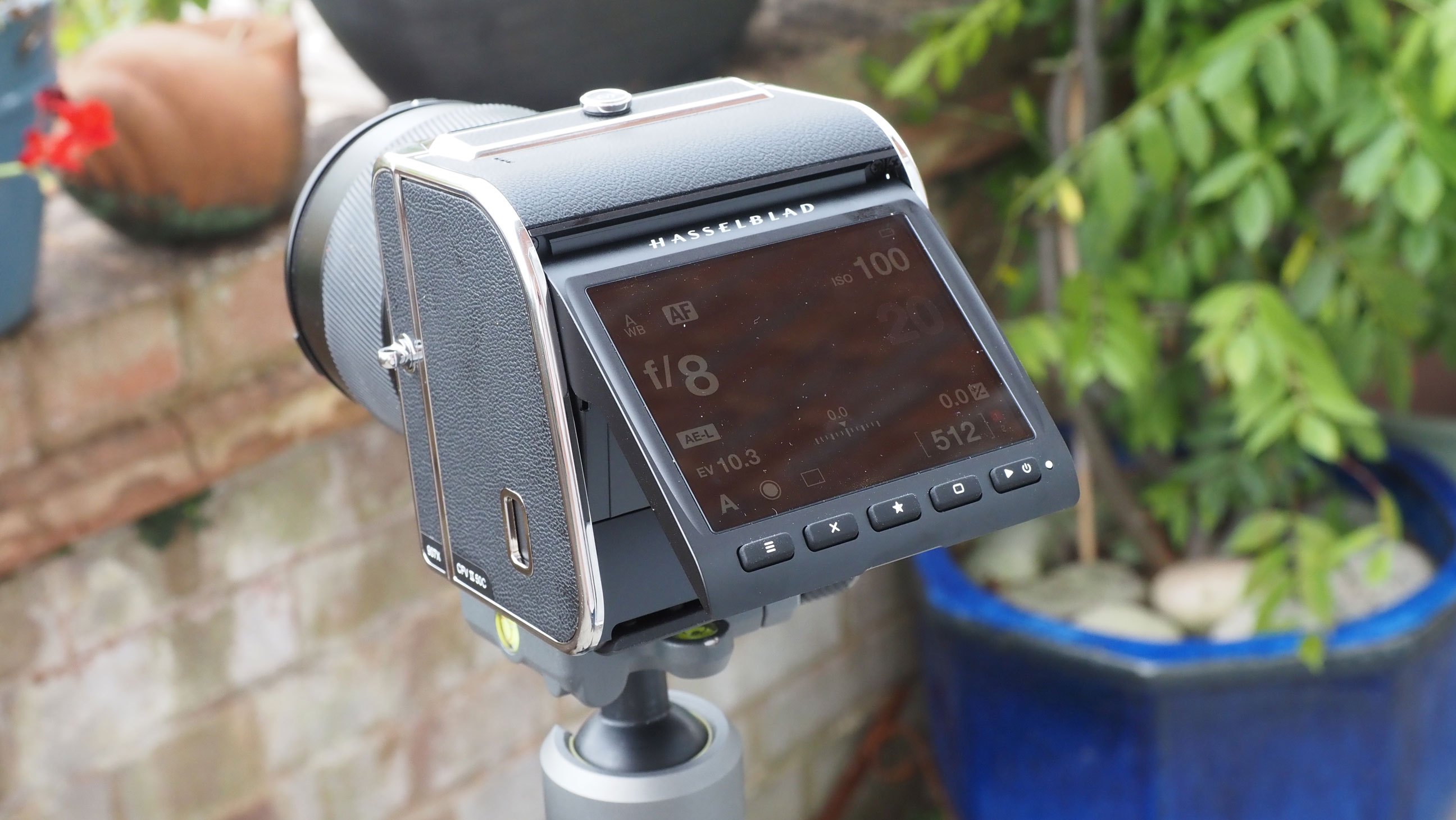
The other thing that works against handheld shooting is the labored contrast autofocus. It’s effective, but it’s not quick and it’s not quiet. We can live with it well enough on the X1D II 50C because the electronic viewfinder makes focus confirmation easy – but when you can’t easily see in bright light where the AF point is or when focus is confirmed on the screen, it makes quick street-style shooting with the 907X a bit tricky.
Also, while you’re grabbing the 907X out of your camera bag, it’s a little too easy to slide open the battery/memory card cover. This could benefit from a stiffer action or an additional release clip.
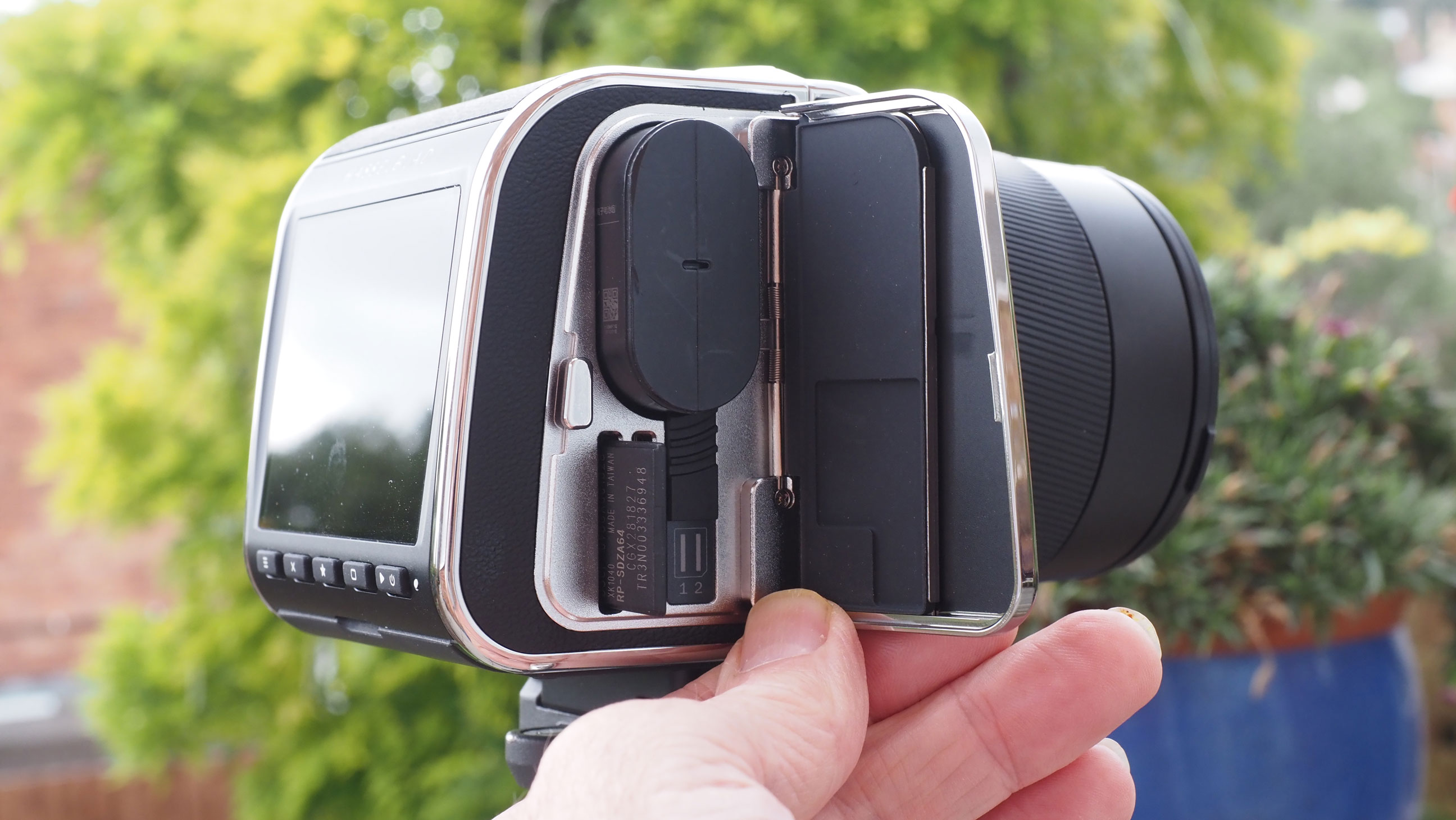
But there is a lot of good news too. The build quality, materials and mechanisms are pure Hasselblad, right down to the black leatherette finish and chrome edging. The digital back clicks on and off as easily as the film backs on old V-series cameras – in fact the lugs are in the same place, the catch clicks into place in the same way and the dimensions of the meeting surfaces are the same.
The interface is entirely digital, but executed really well. It relies on good-sized, properly-spaced icons whose meaning is immediately obvious, and big pop-up scrolling menus for making settings changes to shutter speed, lens aperture, ISO and so on. If ever you’ve been frustrated by cameras with tiny text and complex menu systems, here is a glimpse of how it should be done.
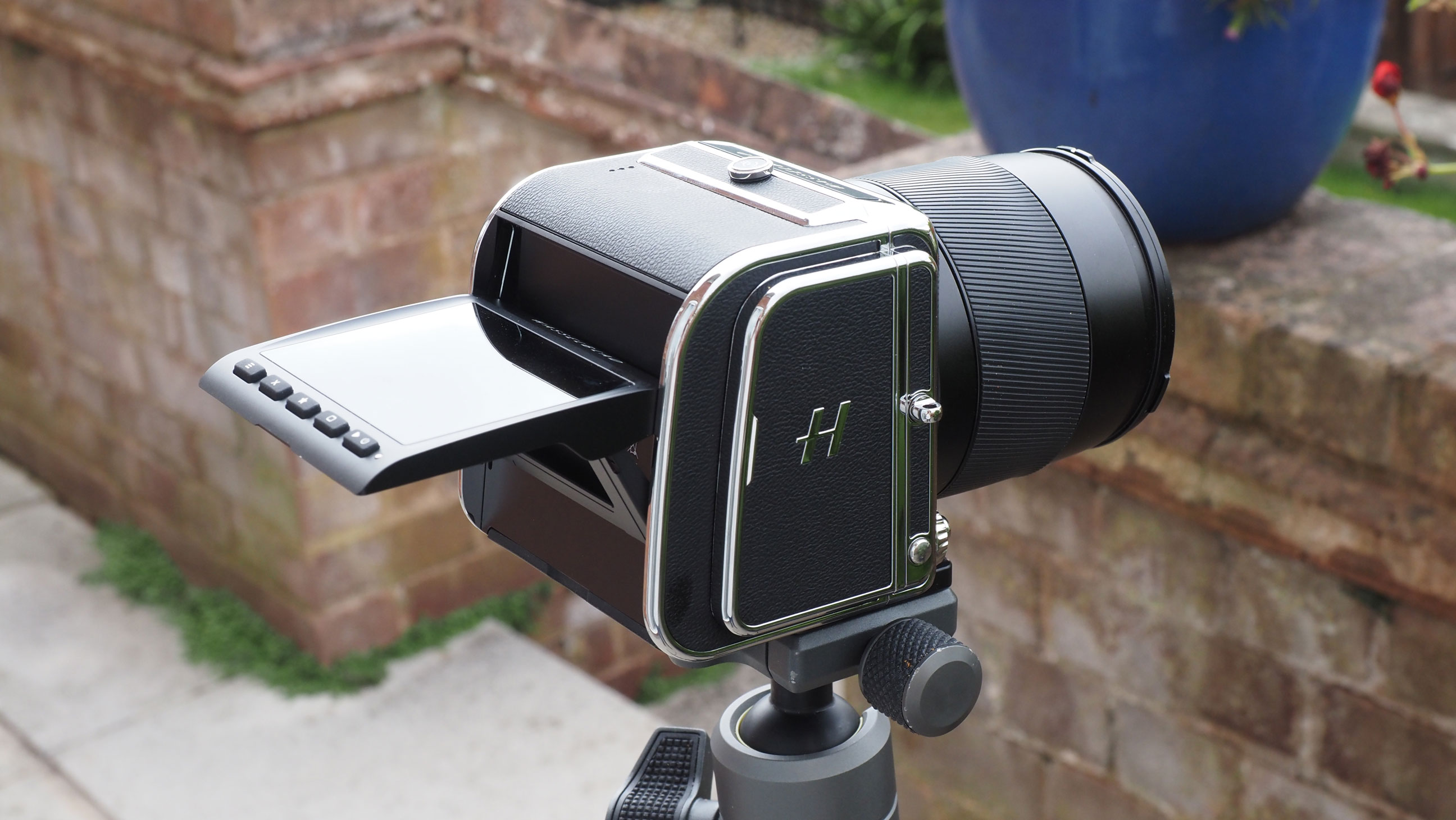
And while the flip-up screen doesn’t do so well in harsh sunlight, the engineering is fabulous. It has two ‘soft’ detentes, one at 45 degrees and one at 90 degrees, and both firm enough that you can tap on the screen without pushing it back down accidentally.
Performance
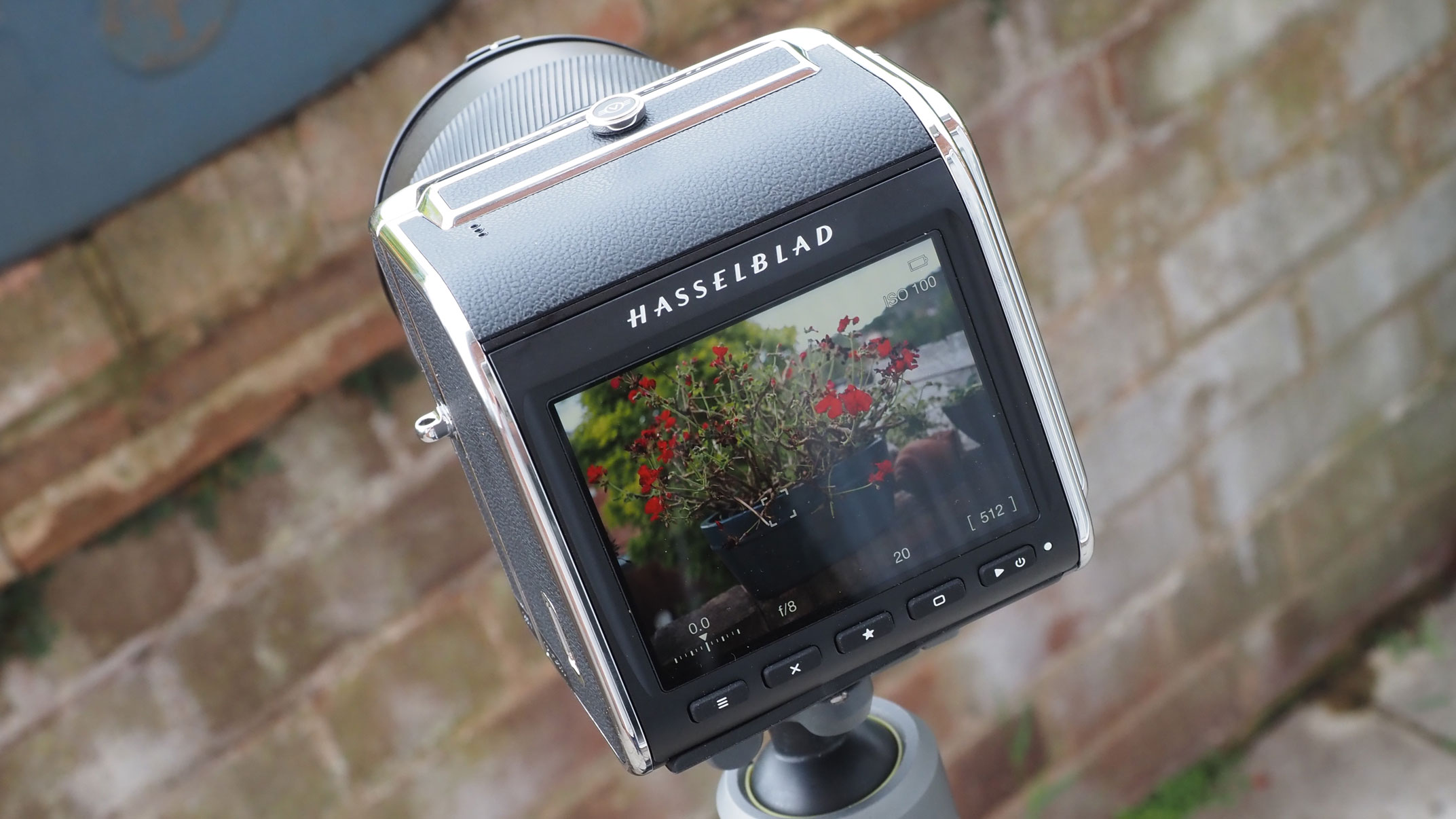
We have not yet completed our suite of lab tests on the 907X and will update this review just as soon as we have the lab results. We expect a very similar performance to the Hasselblad X1D 50C, but hardware is changing all the time, so we want to make sure.
Our comments so far are based on our real-world testing, shooting both JPEGs and raw files, and checking the raws in both Adobe Camera Raw and Hasselblad’s own Phocus software.
We won’t dwell on the autofocus performance, which we’ve already talked about. It’s not quick and it’s not quite, though with the touchscreen AF point selection you can pick an AF point pretty well anywhere.
This also works with the Phocus Mobile app, which requires the usual Wi-Fi registration rigmarole when you first connect it, but works really well after that. You can use a phone, but it’s even better on an iPad Pro, where it feels half way towards a tethered shooting experience, with a good deal of control over the camera settings.

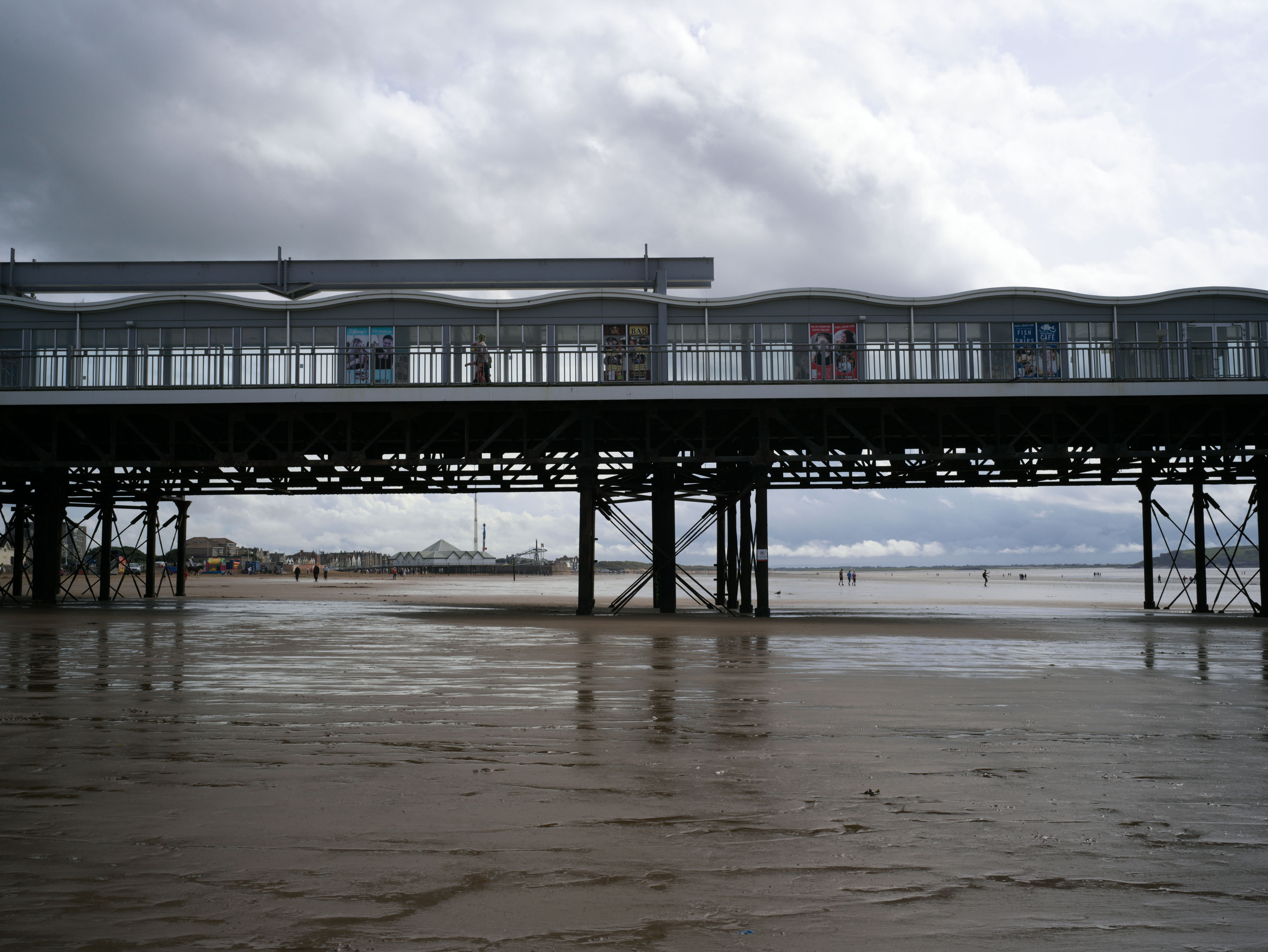
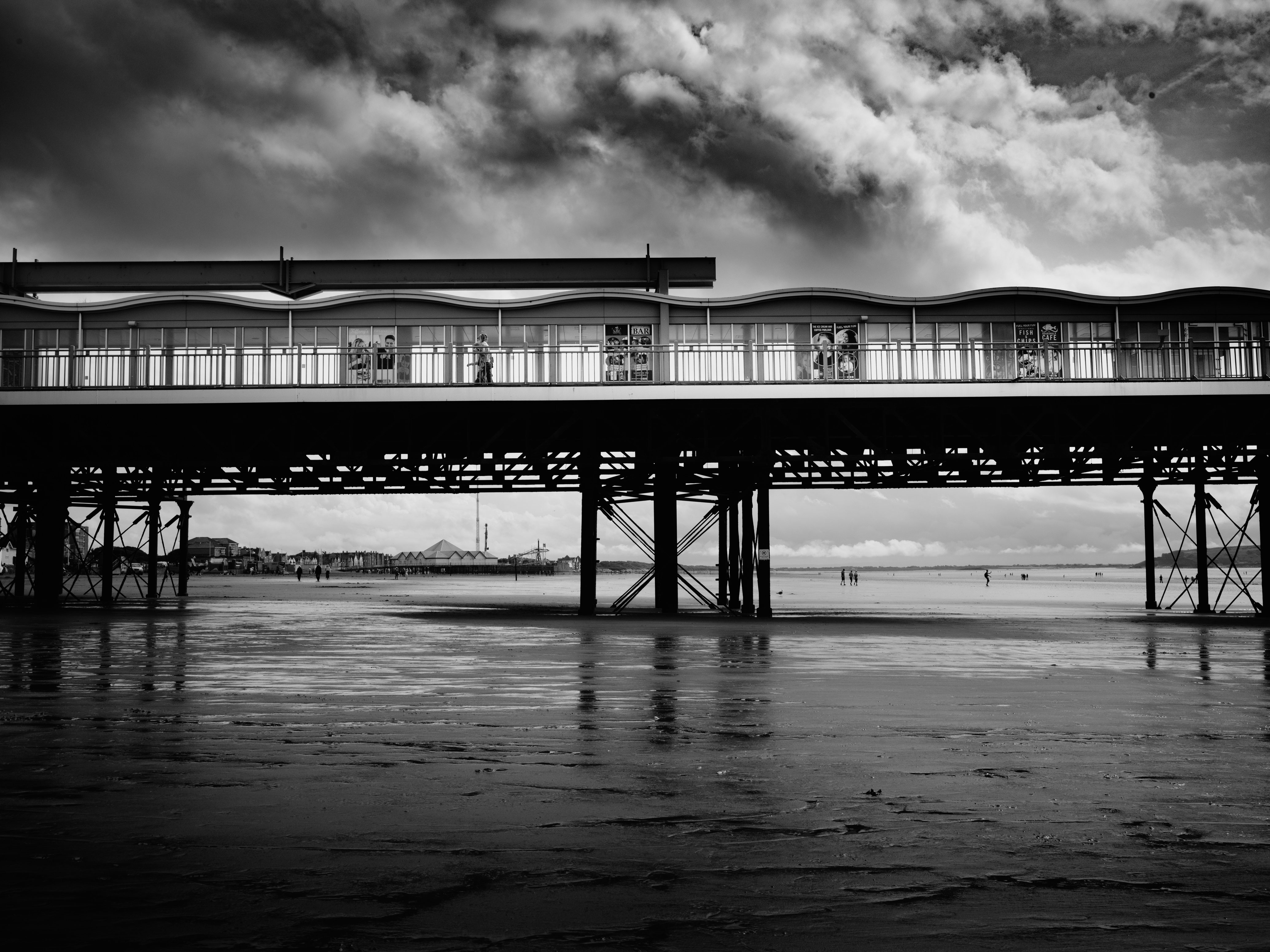


Our sample images show all the color fidelity, dynamic range and sharpness we admire in the X1D II 50C. Are the images better than those of a full frame camera with the same resolution? We don’t think you’ll see much difference in detail rendition, but the raw files from the 907X have a very impressive tonal range and seem to respond very well to shadow and highlight recovery with high contrast scenes. They also have an indefinable 'clarity' that seems a property of big sensors.
We tested the 907X with the XCD 45mm f/3.5 lens (36mm equivalent), which offers impressive edge to edge visual sharpness and very low levels of fringing and distortion. Hasselblad’s XCD lenses might be expensive in regular camera terms, but they are also extremely good. The medium format market will not tolerate indifferent lenses in the way that the consumer market often does.
• Read more: The best Hasselblad lenses today
You have to be careful if you are going to shoot handheld. There is no stabilisation either in the body or the lenses, and any camera movement or focus error will detract from the crystalline clarity this camera is capable of.
Lab data
We compared the 907X's lab results with those from two rival full-frame mirrorless cameras - the medium format Fujifilm GFX 50R, and the full-frame but super-high-megapixel Sony A7R IV, to see if it's really worth going medium format. We've also included the 907X's own stablemate, the X1D II 50C.
Resolution:
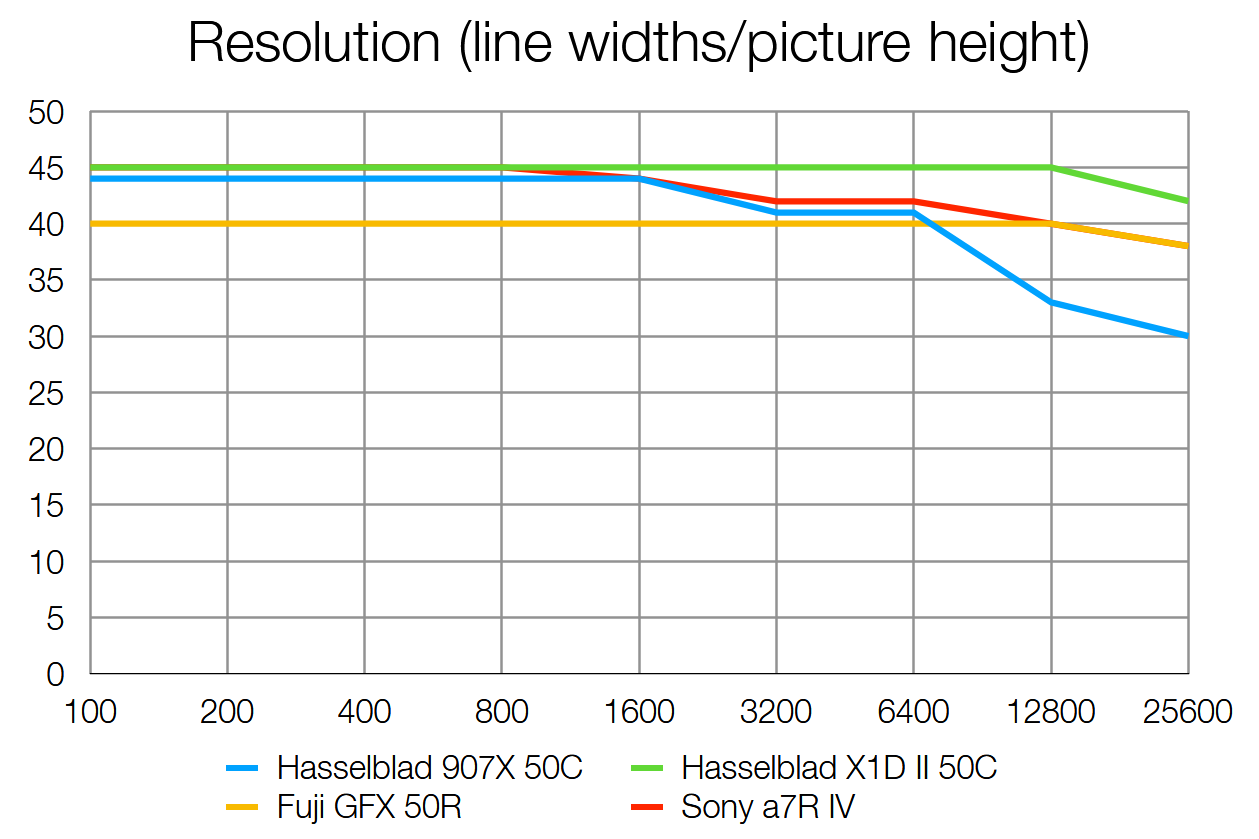
Resolution is measured in line widths/picture height, a widely used standard for resolution measurement that's independent of sensor size.
At lower sensitivities, the 907X resolves pretty much the same amount of detail as the X1D II 50C - no surprise there, as they're both 50MP cameras. What's more interesting is what happens once you pass ISO 1600, as at higher ISOs a huge gulf opens up between the two Hasselblad cameras, with the older X1D II 50C able to resolve significantly more detail than the 907X. This is due to the latter producing noticeably more image noise that masks fine detail. Whether this is due to different in-camera image processing, or a change in Hasselblad Phocus's raw processing is something we need to investigate further.
Dynamic range:
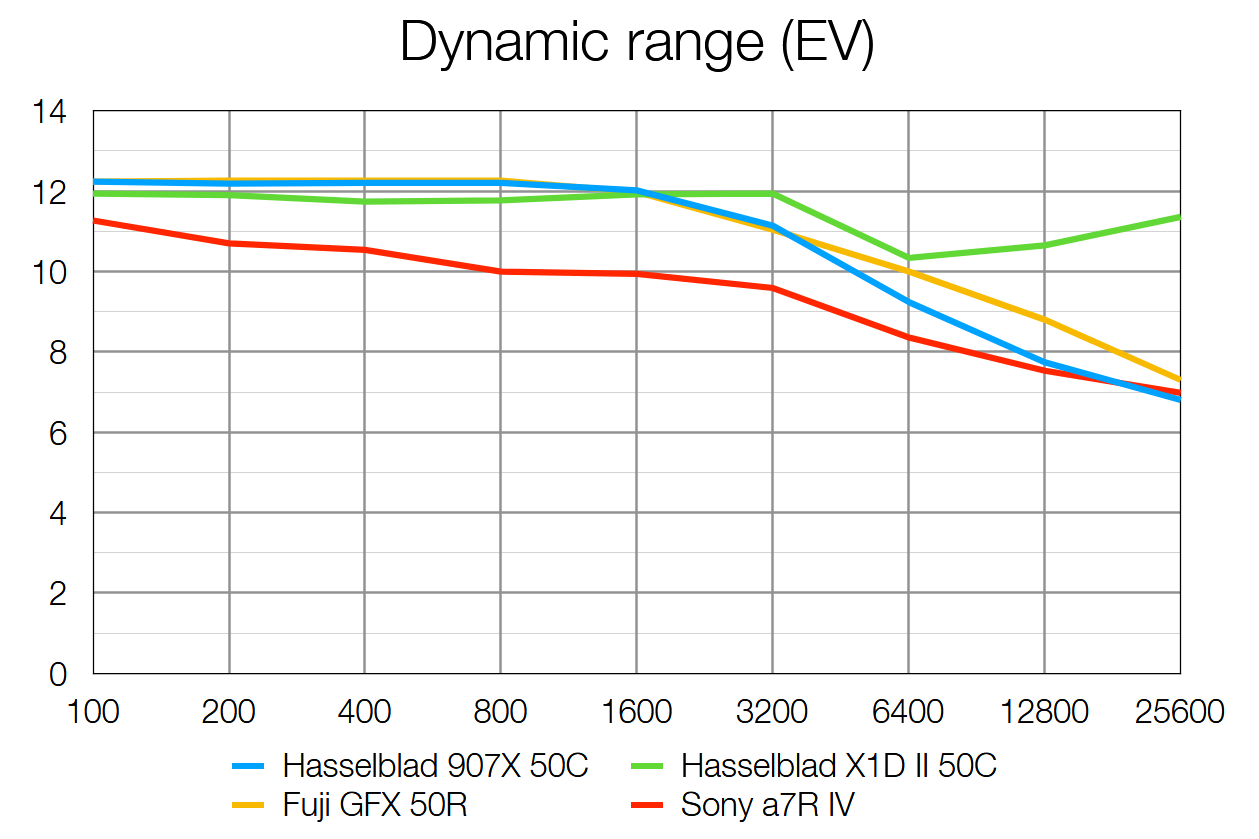
Dynamic range is measured in EV (exposure values, or 'stops'). It's a measure of the camera's ability to record detail in extremely bright and dark areas of the scene. The higher the value, the better.
In this test the 907X performs much better, equally the GFX 50R up to ISO 3200, and slightly outdoing the X1D II 50C. Once you pass ISO 3200 the Fujifilm camera is able to capture around 1 stop more dynamic range than the 907X. But the elephant in the room is the the X1D II, which captures more dynamic range once you pass ISO 6400. That's simply not possible without some form of image processing trickery. Where possible, we always disable any in-camera dynamic range enhancement in order to preserve a level playing field when testing. However, Hasselblad's in-camera menu options are intentionally streamlined and the X1D II lacks any dynamic range menu options. It therefore leaves the possibility that the X1D II is applying some high ISO dynamic range enhancement to RAW files behind the scenes that aren't present in the 907X.
Signal to noise ratio:
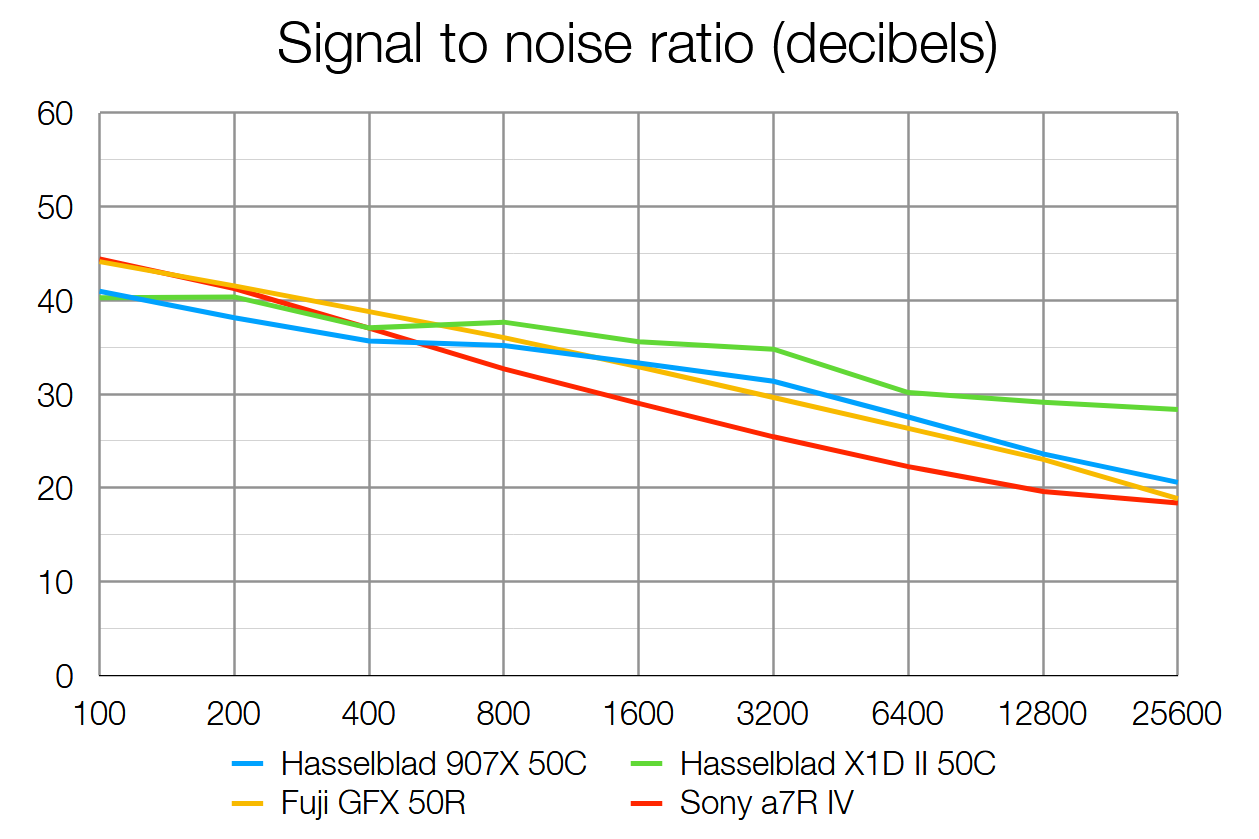
Our signal to noise test measures image clarity, specifically the ratio of the actual image 'data' you want to capture, versus the image noise that you don't want, but will inevitably be visible when shooting at higher ISO sensitivities. The higher the score at a given ISO sensitivity, the better.
This test helps explain the 907X's poor resolution scores at higher ISOs, as it proves that images are noisier throughout the sensitivity scale than those from the X1D II 50C, with the gap being especially prevalent at ISO 12,800 and above. However the 907X is still producing cleaner images than the Fujifilm and Sony cameras at higher ISOs. We are in the process of reprocessing our test images from the X1D II 50C to establish whether the disparity between their lab scores is due to in-camera processing, or simply a change in Phocus's raw processing engine.
Verdict

If you come to the 907X straight from a ‘regular’ camera just looking for something bigger and better, there’s a lot to find fault with. It’s not aimed at you. The Hasselblad 907X 50C is for professional/commercial/fine art photographers who need adaptability of operation and design and, above all, quality of results, and who are prepare to slow down to get it. What the 907X 50C delivers is all of these things, and at a price point that is a first for the medium format market.
Read more:
• The best medium format cameras today
• The best professional cameras to buy
• Hasselblad X1D II 50C review
• Fujifilm GFX 50S review
• The 12 highest resolution cameras you can buy today

Rod is an independent photography journalist and editor, and a long-standing Digital Camera World contributor, having previously worked as DCW's Group Reviews editor. Before that he has been technique editor on N-Photo, Head of Testing for the photography division and Camera Channel editor on TechRadar, as well as contributing to many other publications. He has been writing about photography technique, photo editing and digital cameras since they first appeared, and before that began his career writing about film photography. He has used and reviewed practically every interchangeable lens camera launched in the past 20 years, from entry-level DSLRs to medium format cameras, together with lenses, tripods, gimbals, light meters, camera bags and more. Rod has his own camera gear blog at fotovolo.com but also writes about photo-editing applications and techniques at lifeafterphotoshop.com

